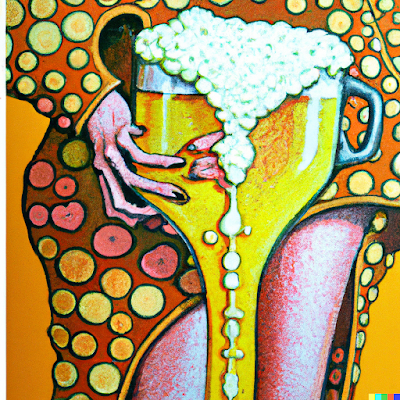1. Bottling Over the Dishwasher Door: When bottling your beer, consider setting up your operation over the open dishwasher door. This way, if any spills or drips occur during the process, they can be easily cleaned up by simply closing the door. It saves you the hassle of having to mop up the mess separately.
2. Cleaning the 'Boil in a Bag' Brew Bag: After using a 'Boil in a Bag' brew bag, cleaning it properly ensures its longevity and prevents any unwanted flavors from transferring to future batches. Start by shaking the bag out to remove any loose debris. Then, turn it inside out and hold it under the shower or a faucet to thoroughly rinse off any remaining residue. This ensures that your bag is clean and ready for the next brew.
3. Pouring Extract from a Bowl: When working with dry malt extract (DME), transferring it from the bag to the boiling water can be a bit challenging. To make the process easier, pour the contents of the bag into a bowl first and then use the bowl to pour the extract into the boiling water. This way, you can scrape out every last bit of the extract from the bowl, ensuring maximum utilization of your ingredients.
4. Importance of Fresh Ingredients: The quality of your homebrewed beer greatly depends on the freshness of the ingredients you use. Just like in cooking, using fresh and high-quality ingredients will result in a better end product. Therefore, strive to source fresh malts, hops, and yeast to ensure that your beer reaches its full potential in terms of flavor, aroma, and overall quality.
5. Handling Dry Malt Extract (DME): Dry malt extract has a tendency to cake onto the sides of the bag when exposed to steam from boiling water. This can make it difficult to measure and utilize fully. To overcome this issue, consider adding the DME to the brew kettle before adding the boiling water. This way, the steam will not cause excessive caking, and you can extract the full amount of DME without any wastage.
6. Re-hydrating Dry Yeast: If you have saved dry yeast for future use, re-hydrating it properly is crucial to ensure its viability and effectiveness in fermentation. One effective method is to pour the dry yeast into a plastic bottle filled with water at the correct temperature. Cap the bottle and shake it gently to mix the yeast with the water. Open the bottle slightly to release any excess gas (similar to burping a soda bottle). When it's time to pitch the yeast, pour it out of the bottle directly into your wort, allowing for a smooth and efficient fermentation process.
7. Silica Gel in Hydrometer Case: While some brewers find it unnecessary, placing a packet of silica gel in your hydrometer case can help absorb any residual moisture that might be present after using the hydrometer. This extra precaution ensures that the hydrometer remains in optimal condition and provides accurate readings for future measurements.
8. pH Meter for Mash Testing: Monitoring the pH level during the mashing process can significantly impact the quality of your beer. Using a pH meter to test the mash allows you to adjust the acidity and alkalinity levels as needed, ensuring optimal enzyme activity and flavor development. Aim for a pH range that is suitable for the style of beer you are brewing, as different styles have different ideal pH ranges.
9. Selecting the Right Hops: Hops play a crucial role in the flavor and aroma profile of your beer. To achieve the best results, it's essential to choose hops that complement the specific style of beer you are brewing. Research the different hop varieties and their characteristics to find the ones that align with your desired flavor profile. Experimenting with different hop combinations can lead to exciting and unique brews.
10. Lager Hops for Matching Styles: When brewing lagers, certain hop varieties are known to work exceptionally well. Saaz hops, traditionally associated with lagers, impart a delicate and spicy aroma, while the classic German hop, Hallertauer, adds a mild and floral character. Additionally, exploring hops like the New Zealand-derived Green Bullet can provide interesting flavor dimensions to lagers.
 |
| What does an Alien brew taste like? |
11. Boiling Malt Extract Kits: Contrary to popular belief, boiling malt extract kits can actually enhance the quality of your beer. Boiling the malt extract ensures sterilization and eliminates any unwanted microorganisms. Moreover, it allows you to precisely control hop timings and achieve the desired bitterness and flavor extraction from the hops.
12. Yeast Starter Management: When making a yeast starter, it's crucial to take precautions to contain any potential overflow. Placing the flask inside a plastic grocery bag before putting it on a stir plate provides an additional layer of protection. In the event of an overflow, the mess will be contained within the plastic bag, preventing any contamination and making cleanup easier.
13. Proper Sugar Amount in Bottles: Avoid the temptation to add excessive amounts of sugar when priming your beer for carbonation in bottles. Over-carbonation can lead to gushers or even exploding bottles. Follow a reliable priming sugar calculator to determine the correct amount of sugar needed based on the beer style and desired carbonation level.
14. Slanted Yeast Cake: Creating a slanted yeast cake in your fermenter can be advantageous when it comes time to rack the beer. By placing a book or wedge under the back of the fermenter after sealing it, you can create a slanted surface where the yeast settles. This allows for clearer beer transfer from the front side of the fermenter, reducing the risk of disturbing the sediment.
15. Calculating Alcohol Content with a Hydrometer: A hydrometer can be a useful tool for determining the alcohol content of your beer. By measuring the specific gravity (SG) before and after fermentation, you can calculate the alcohol by volume (ABV) using a simple formula. This information helps you track and adjust the strength of your beer in subsequent brews.
16. Carbonation Drops Quantity: When using carbonation drops for bottle conditioning, a general rule of thumb is to use around 60 carbonation drops for a 23-liter brew. However, it's always best to refer to the specific instructions provided by the manufacturer of your chosen carbonation drops, as quantities may vary.
17. Preventing Boil Overs: Boil overs can create a messy and time-consuming cleanup process. To minimize the risk, consider adding a few marbles, glass beads, or large stainless steel ball bearings to your boil kettle. These objects act as nucleation points at the bottom, allowing large bubbles to rise and pop, thus reducing foam formation. Alternatively, using a foam inhibitor such as Fermcap-S can also help prevent boil overs effectively.
18. Rapid Wort Cooling: Cooling your wort quickly after boiling is important to encourage the precipitation of unwanted proteins and tannins, which can negatively affect the flavor and clarity of your beer. Utilize a wort chiller or an ice bath to rapidly cool the wort to the desired temperature before pitching the yeast.
19. Spray Bottle for Sanitizing: Simplify the sanitizing process by using a spray bottle filled with a Star San solution. Instead of dunking everything in a bucket of sanitizer, you can spray the surfaces liberally, ensuring good coverage and saving time. This method is particularly useful for smaller items and hard-to-reach areas.
20. Spigots in Fermenting Buckets: Installing spigots in your fermenting buckets can streamline the beer transfer process. With a spigot, you can attach an auto siphon directly to the bucket, eliminating the need for manual siphoning and reducing the risk of contamination.
21. Harvesting Yeast Slurry: When transferring beer from a fermenter to a keg, consider collecting a portion of the yeast slurry in pint mason jars. Refrigerate these jars for future use as yeast starters in subsequent brews. This technique helps save money on yeast purchases and ensures consistent fermentation performance.
22. Sodium Percarbonate for Sanitization: Sodium percarbonate, a powdered compound, is a preferred method for sanitizing brewing equipment. It effectively eliminates bacteria and unwanted microorganisms without leaving residue. Its no-rinse nature simplifies the sanitization process, and it can be conveniently ordered in bulk online.
23. Hops Tea for Flavor Extraction: To ensure optimal extraction of hop flavors, consider making a "hops tea" before adding them to your beer. Simmer a small amount of hops in water for a short period, then strain the liquid and incorporate it into your brew. This technique can enhance the hop character and provide a more pronounced aroma in the finished beer.
24. Bulk Purchase of Hops: If you brew beer frequently or enjoy experimenting with different hop varieties, buying hops in bulk can be a cost-effective option. However, ensure that you have proper storage facilities to maintain the freshness and quality of the hops. Freezing excess hops can help prolong their shelf life and preserve their aroma and bitterness.
25. Patience in Bottling: Don't rush to start the bottling process. Bottling your beer too early can result in undercarbonated or off-flavored beer. Ensure that fermentation is complete and the desired final gravity is reached before proceeding with bottling. Keep the beer in a warm and stable environment during fermentation to encourage proper carbonation.
26. Two Approaches to Adding Sugar: When priming your beer for bottle carbonation, you have two methods to consider. The first method involves priming the entire batch by adding the liquid sugar directly to the fermenter before bottling. The second method involves adding sugar to each bottle individually using a measured amount. Choose the approach that best suits your preference and brewing setup.
27. Creamy Mouthfeel with Unfermentables: If you desire a creamy mouthfeel in your beer, consider incorporating more "unfermentable" sugars by adding additional malt to your recipe. These sugars contribute to a thicker and more viscous texture, resulting in a beer that feels fuller and richer in your mouth.
28. Dishwasher Cleaning for Bottles: Instead of hand cleaning and sanitizing each bottle individually, you can use your dishwasher to streamline the process. Place your empty bottles in the dishwasher's bottom rack without using any detergent. Run the dishwasher on the hottest cycle, ensuring that the high temperature effectively sanitizes the bottles, removes labels, and eliminates any potential contaminants.
29. Increasing ABV with Extra Fermentables: If you want to boost the alcohol content (ABV) of your beer, consider adding extra fermentables to your recipe. Dry malt extract (DME) is a common choice, as it easily dissolves in wort and provides additional sugars for the yeast to convert into alcohol. Adjust the amount of extra fermentables based on your target ABV.
30. Thorough Cleansing and Sterilization: When it comes to brewing, cleanliness and sterilization are vital. Ensure that all equipment, including fermenters, airlocks, tubing, and utensils, undergo thorough cleaning and sanitization before use. Use a dedicated cleansing and sterilizing agent provided in your brewing kit to eliminate any potential contaminants and maintain the integrity of your beer.
31. Extended Aging for Lager Character: If you're brewing lagers, allow your beer to sit for an extended period at cooler temperatures after primary fermentation. This process, known as lagering, allows the flavors to mellow and the beer to clarify, resulting in a smoother and more refined taste. Patience is key when brewing lagers, as the additional aging time contributes significantly to their character.
32. Avoiding Oxygen Exposure: Oxygen exposure can lead to off-flavors and premature staling of your beer. Minimize oxygen contact by utilizing techniques such as closed transfers, purging vessels with CO2 before filling, and using oxygen-absorbing caps or corks for bottle sealing. A well-maintained fermentation environment and proper packaging methods contribute to the longevity and quality of your beer.
Remember, brewing beer is a creative process, and experimentation is encouraged. Take these tips as guidelines and adapt them to your specific brewing setup, style preferences, and desired outcomes. Happy brewing!



0 comments:
Post a Comment